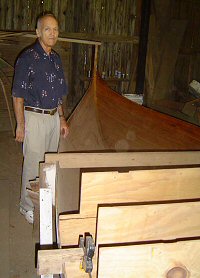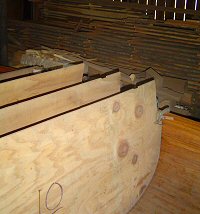Viking Ship to Sail from
Scandanavian Silverhill, Alabama

It was an exciting meeting for Swedish Silverhill and Men's 710, September 9, at Zion Lutheran Church. Can you get more Scandanavian than a Viking ship?

Silverhill's Captain Peter Midgarden has fabricated a 26 foot scale model "Viking ship." In true Viking tradition, the hull of the boat is crafted before the ribbing and support structure is placed within the hull. The bow of the ship (on Midgarden's right) will eventually have that traditional Viking dragon head. "I haven't fabricated that yet, but they only used those for 'dress occasions.'"
- Click to enlarge.
"My Dad's father came from Numedal near Nore and my Gramma from Hallingdal's Flaaten Farm." (Think about Norway and Vikings.) "Their son Gunter, my Dad, came to this country and was a tailor for six months until he was able to homestead in Minnesota before moving to Hoople, ND, where I am from." (His father came with the great Norwegian immigration of the 1800s to the Upper Midwest.) "So I have Viking DNA from that side of the family," Captain Peter Midgarden, US Navy, Retired, opined. "My Mom was from Jutland in northern Germany." (It turns out that Hengest and Horsa, the ones that led the first Saxon raiding bands into England back about AD 450, were from Jutland, the brothers sometimes pictured as landing in England on a Viking style ship.) You can see that Captain Midgarden might have some claim to Viking blood!
But here's where the story gets interesting. This young man from a farm outside Hoople, ND, joins the Navy, but guess what? He becomes a Navy "aviator," not a "seaman."
"Flying was fun and I had a chance to visit Norway about 40 years ago and then again in 1987. That's when I saw a real Viking ship!" You can get a sense of excitement in his voice.

Viking shipwright Peter Midgarden reveals temporary ribbing holding the form of the hull in his replica construction. In true Viking ship construction, the hull was constructed first, then the ribbing inserted, the exact opposite of today's construction techniques. Midgarden has employed a laminating technique in his replica hull.
- Click to enlarge.
Captain Midgarden retires, moves to Silverhill, AL, and begins dabbling in farming--it is in his North Dakotan blood, you know. He's a man of projects and decides to build a canoe. He finishes that project and begins thinking about doing a Viking ship, because "I wanted to sail a square-sail rigged ship."
There are plenty of pictures of Viking ships, but not many plans around. He started collecting information and discovered a teacher up in Maine who had a schematic labeled in German. From these metric plans, Captain Midgarden did a scale model in 1997-1998. It took two years and 200 hours of research to get beyond this point.
He began to collect materials locally. All the oak that has ended up in his Viking scale replica ship came from Silverhill. As materials were sized and planed to plan, Midgarden began laying out the ship. "The real difficulty was bringing modern shipbuilding techniques to the crafting of an ancient ship," he says. His strategy was to make pieces small enough for one-man assembly. The hull of the ship was crafted first. To this point, the hull is completed, fiberglassed, and finished. It has taken about a 1000 hours.

Each of the temporary ribs of this Viking ship hull have different dimensions in this tapered hull. Note that the ribs are held in place by clamps. The laminated hull with its fiberglass and numerous coatings make for a rigid hull, even without ribs.
- Click to enlarge.
The next 1000 hours will involve placing ribs into the ship--there are 20 of those ribs to fabricate. They will be placed into the existing hull to add rigidity and ultimately will be fastened to the hull. The decking of this ship will be the last phase before mast and sail. The Vikings did not fasten the decking to their ships, but left them loose so that things could be stored under the deck.
"When I get done, I will have a 26 foot ship, about 5-1/2 feet wide, and square-rigged. I started this project just to have fun. It hasn't been work time," Midgarden noted. So, I asked him, "What are you going to do when you are done?" His simple answer? "Sail it!"






|